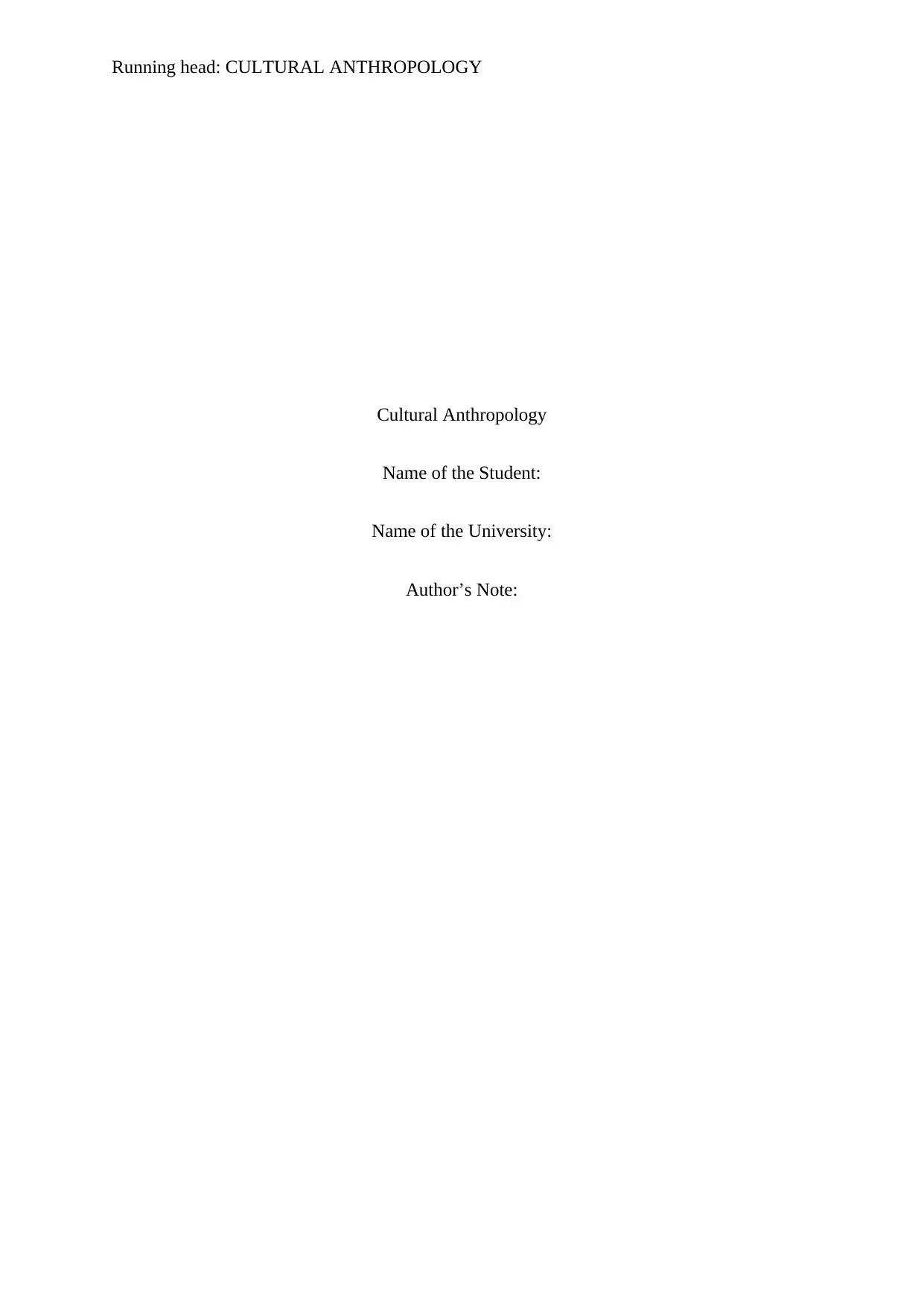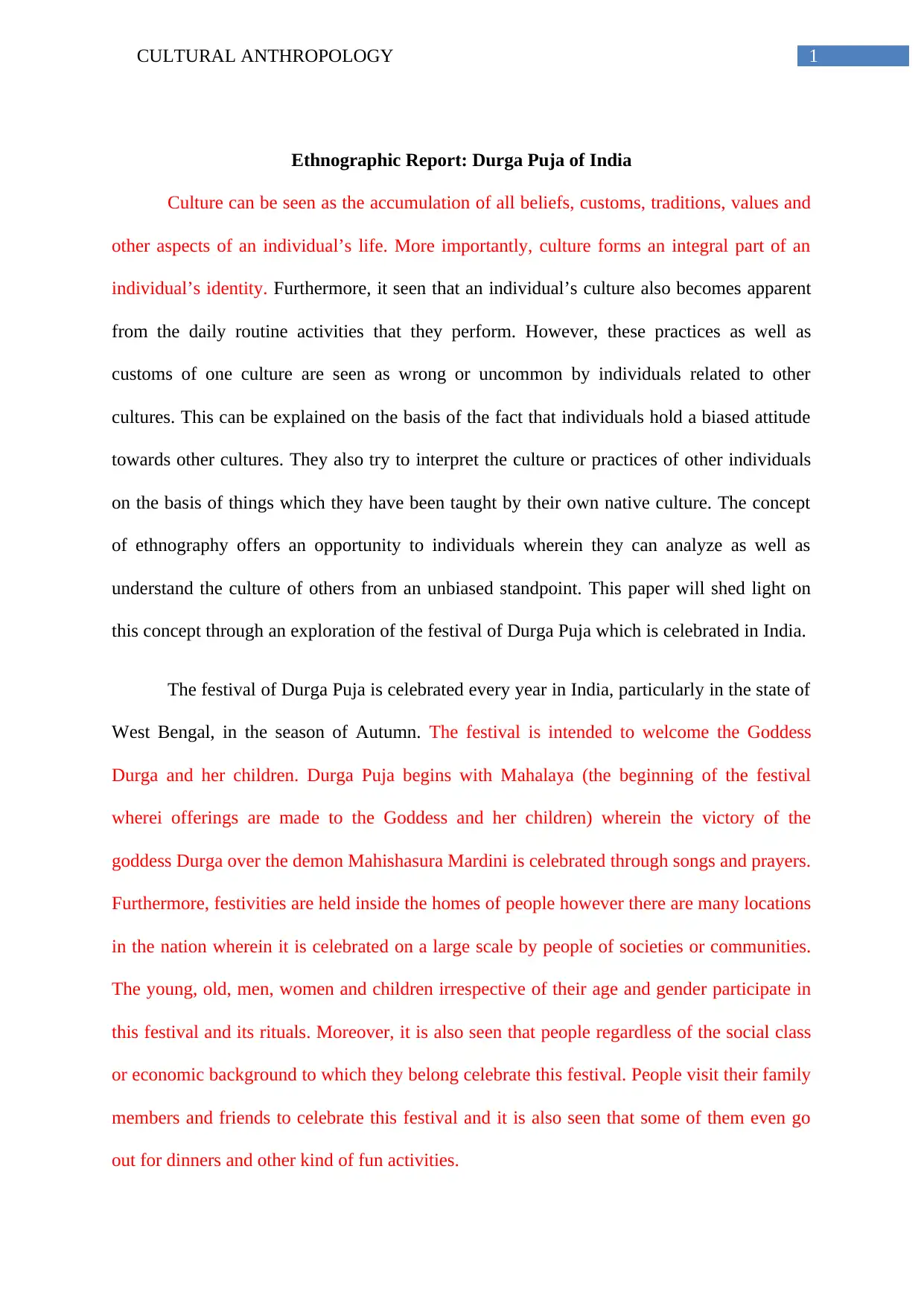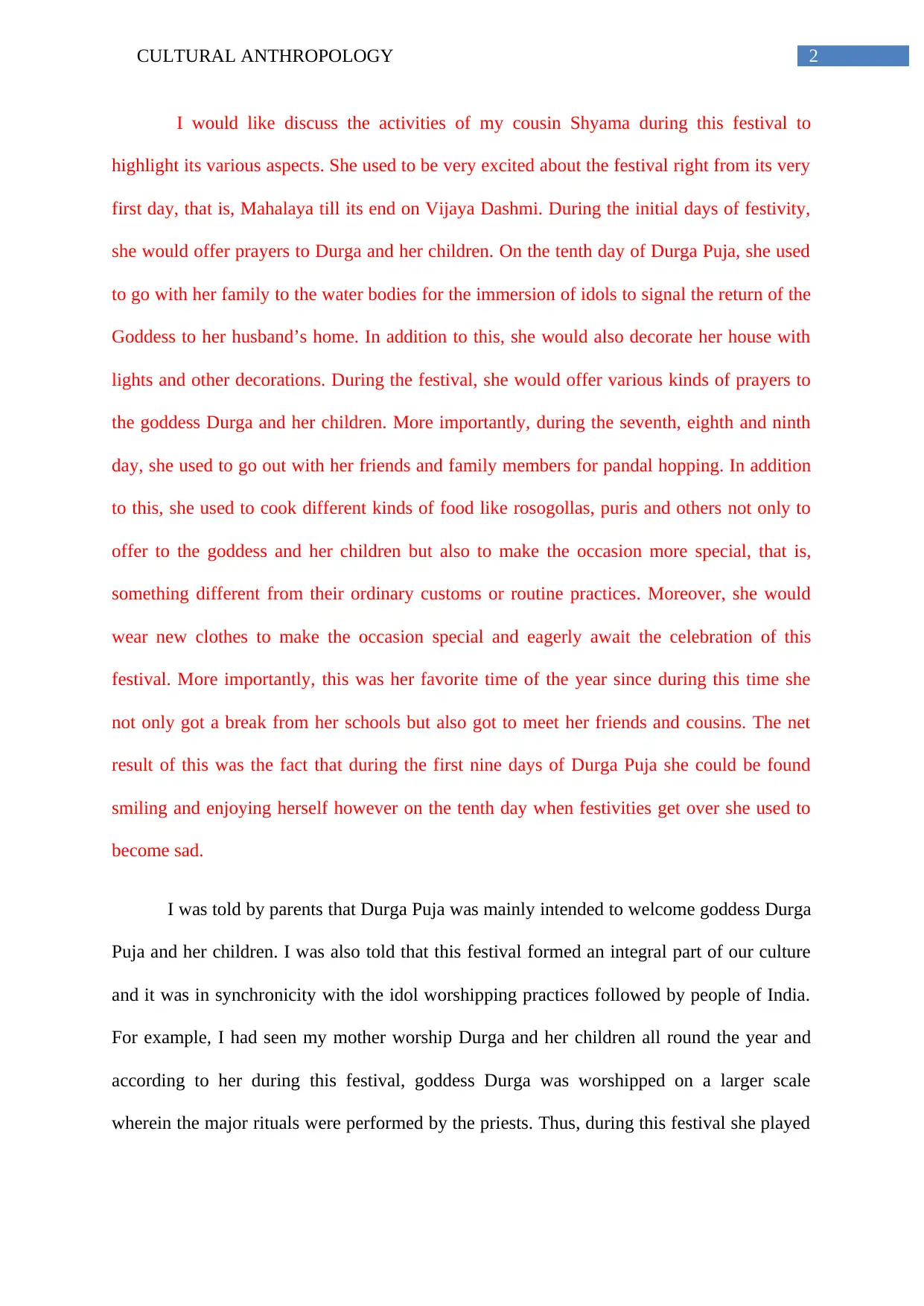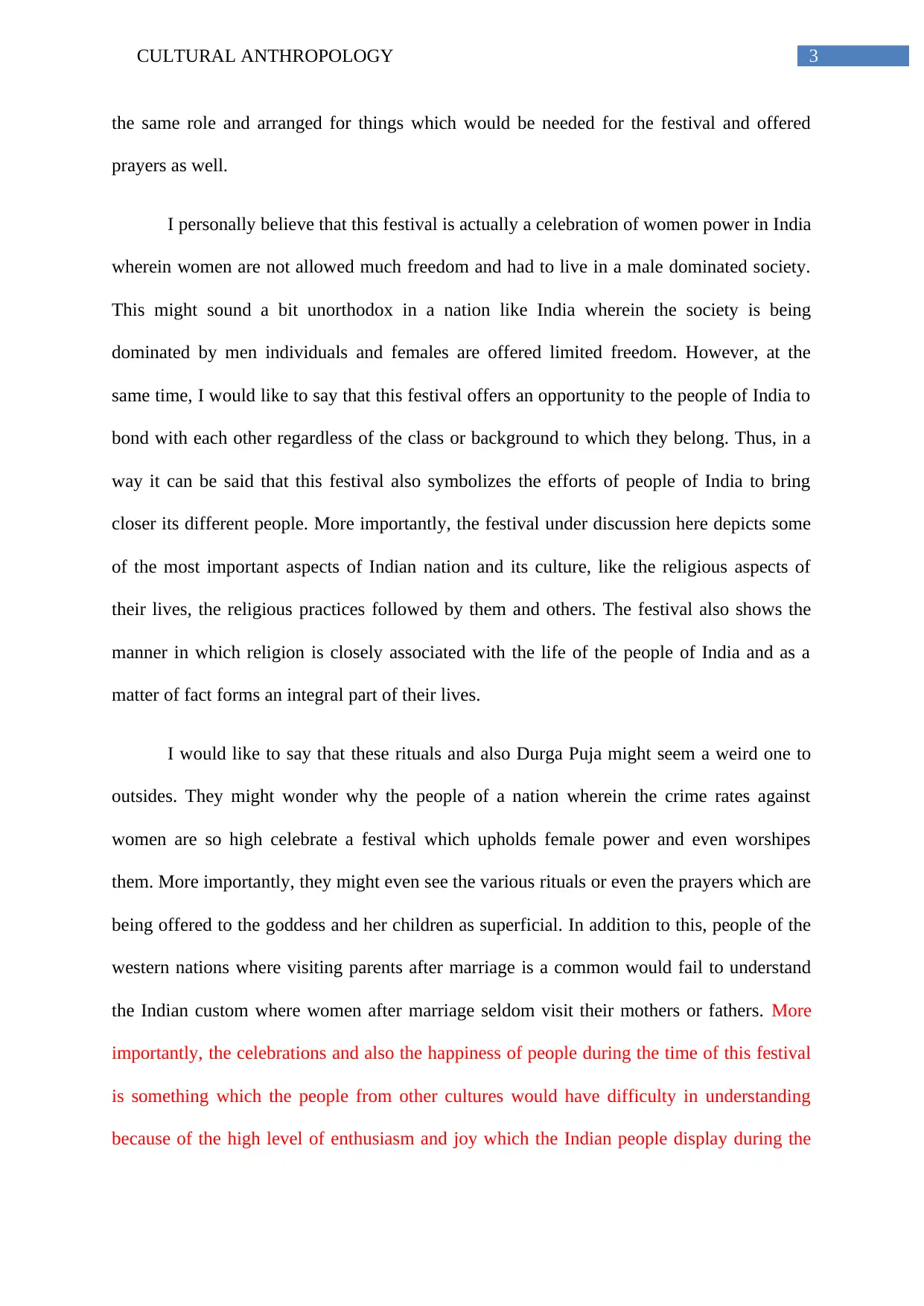ANTH 1120: Ethnographic Report on Durga Puja Festival in India
VerifiedAdded on 2023/06/03
|5
|1234
|190
Report
AI Summary
This ethnographic report delves into the cultural significance of Durga Puja, a prominent festival celebrated in India, particularly in West Bengal. The report highlights the festival's traditions, rituals, and its importance in Indian culture. It emphasizes the welcoming of Goddess Durga and her children, the celebrations, and the participation of people from various social and economic backgrounds. The author shares personal experiences through the activities of a family member, detailing the prayers, decorations, pandal hopping, and special food preparations associated with the festival. The report further explores the festival's connection to Indian idol worshiping practices and its role in celebrating women's power. It acknowledges potential misinterpretations by individuals from different cultural backgrounds due to varying customs and beliefs. The report concludes by asserting that Durga Puja embodies crucial aspects of Indian culture, including religious practices and the close association of religion with people's lives.

Running head: CULTURAL ANTHROPOLOGY
Cultural Anthropology
Name of the Student:
Name of the University:
Author’s Note:
Cultural Anthropology
Name of the Student:
Name of the University:
Author’s Note:
Paraphrase This Document
Need a fresh take? Get an instant paraphrase of this document with our AI Paraphraser

1CULTURAL ANTHROPOLOGY
Ethnographic Report: Durga Puja of India
Culture can be seen as the accumulation of all beliefs, customs, traditions, values and
other aspects of an individual’s life. More importantly, culture forms an integral part of an
individual’s identity. Furthermore, it seen that an individual’s culture also becomes apparent
from the daily routine activities that they perform. However, these practices as well as
customs of one culture are seen as wrong or uncommon by individuals related to other
cultures. This can be explained on the basis of the fact that individuals hold a biased attitude
towards other cultures. They also try to interpret the culture or practices of other individuals
on the basis of things which they have been taught by their own native culture. The concept
of ethnography offers an opportunity to individuals wherein they can analyze as well as
understand the culture of others from an unbiased standpoint. This paper will shed light on
this concept through an exploration of the festival of Durga Puja which is celebrated in India.
The festival of Durga Puja is celebrated every year in India, particularly in the state of
West Bengal, in the season of Autumn. The festival is intended to welcome the Goddess
Durga and her children. Durga Puja begins with Mahalaya (the beginning of the festival
wherei offerings are made to the Goddess and her children) wherein the victory of the
goddess Durga over the demon Mahishasura Mardini is celebrated through songs and prayers.
Furthermore, festivities are held inside the homes of people however there are many locations
in the nation wherein it is celebrated on a large scale by people of societies or communities.
The young, old, men, women and children irrespective of their age and gender participate in
this festival and its rituals. Moreover, it is also seen that people regardless of the social class
or economic background to which they belong celebrate this festival. People visit their family
members and friends to celebrate this festival and it is also seen that some of them even go
out for dinners and other kind of fun activities.
Ethnographic Report: Durga Puja of India
Culture can be seen as the accumulation of all beliefs, customs, traditions, values and
other aspects of an individual’s life. More importantly, culture forms an integral part of an
individual’s identity. Furthermore, it seen that an individual’s culture also becomes apparent
from the daily routine activities that they perform. However, these practices as well as
customs of one culture are seen as wrong or uncommon by individuals related to other
cultures. This can be explained on the basis of the fact that individuals hold a biased attitude
towards other cultures. They also try to interpret the culture or practices of other individuals
on the basis of things which they have been taught by their own native culture. The concept
of ethnography offers an opportunity to individuals wherein they can analyze as well as
understand the culture of others from an unbiased standpoint. This paper will shed light on
this concept through an exploration of the festival of Durga Puja which is celebrated in India.
The festival of Durga Puja is celebrated every year in India, particularly in the state of
West Bengal, in the season of Autumn. The festival is intended to welcome the Goddess
Durga and her children. Durga Puja begins with Mahalaya (the beginning of the festival
wherei offerings are made to the Goddess and her children) wherein the victory of the
goddess Durga over the demon Mahishasura Mardini is celebrated through songs and prayers.
Furthermore, festivities are held inside the homes of people however there are many locations
in the nation wherein it is celebrated on a large scale by people of societies or communities.
The young, old, men, women and children irrespective of their age and gender participate in
this festival and its rituals. Moreover, it is also seen that people regardless of the social class
or economic background to which they belong celebrate this festival. People visit their family
members and friends to celebrate this festival and it is also seen that some of them even go
out for dinners and other kind of fun activities.

2CULTURAL ANTHROPOLOGY
I would like discuss the activities of my cousin Shyama during this festival to
highlight its various aspects. She used to be very excited about the festival right from its very
first day, that is, Mahalaya till its end on Vijaya Dashmi. During the initial days of festivity,
she would offer prayers to Durga and her children. On the tenth day of Durga Puja, she used
to go with her family to the water bodies for the immersion of idols to signal the return of the
Goddess to her husband’s home. In addition to this, she would also decorate her house with
lights and other decorations. During the festival, she would offer various kinds of prayers to
the goddess Durga and her children. More importantly, during the seventh, eighth and ninth
day, she used to go out with her friends and family members for pandal hopping. In addition
to this, she used to cook different kinds of food like rosogollas, puris and others not only to
offer to the goddess and her children but also to make the occasion more special, that is,
something different from their ordinary customs or routine practices. Moreover, she would
wear new clothes to make the occasion special and eagerly await the celebration of this
festival. More importantly, this was her favorite time of the year since during this time she
not only got a break from her schools but also got to meet her friends and cousins. The net
result of this was the fact that during the first nine days of Durga Puja she could be found
smiling and enjoying herself however on the tenth day when festivities get over she used to
become sad.
I was told by parents that Durga Puja was mainly intended to welcome goddess Durga
Puja and her children. I was also told that this festival formed an integral part of our culture
and it was in synchronicity with the idol worshipping practices followed by people of India.
For example, I had seen my mother worship Durga and her children all round the year and
according to her during this festival, goddess Durga was worshipped on a larger scale
wherein the major rituals were performed by the priests. Thus, during this festival she played
I would like discuss the activities of my cousin Shyama during this festival to
highlight its various aspects. She used to be very excited about the festival right from its very
first day, that is, Mahalaya till its end on Vijaya Dashmi. During the initial days of festivity,
she would offer prayers to Durga and her children. On the tenth day of Durga Puja, she used
to go with her family to the water bodies for the immersion of idols to signal the return of the
Goddess to her husband’s home. In addition to this, she would also decorate her house with
lights and other decorations. During the festival, she would offer various kinds of prayers to
the goddess Durga and her children. More importantly, during the seventh, eighth and ninth
day, she used to go out with her friends and family members for pandal hopping. In addition
to this, she used to cook different kinds of food like rosogollas, puris and others not only to
offer to the goddess and her children but also to make the occasion more special, that is,
something different from their ordinary customs or routine practices. Moreover, she would
wear new clothes to make the occasion special and eagerly await the celebration of this
festival. More importantly, this was her favorite time of the year since during this time she
not only got a break from her schools but also got to meet her friends and cousins. The net
result of this was the fact that during the first nine days of Durga Puja she could be found
smiling and enjoying herself however on the tenth day when festivities get over she used to
become sad.
I was told by parents that Durga Puja was mainly intended to welcome goddess Durga
Puja and her children. I was also told that this festival formed an integral part of our culture
and it was in synchronicity with the idol worshipping practices followed by people of India.
For example, I had seen my mother worship Durga and her children all round the year and
according to her during this festival, goddess Durga was worshipped on a larger scale
wherein the major rituals were performed by the priests. Thus, during this festival she played
⊘ This is a preview!⊘
Do you want full access?
Subscribe today to unlock all pages.

Trusted by 1+ million students worldwide

3CULTURAL ANTHROPOLOGY
the same role and arranged for things which would be needed for the festival and offered
prayers as well.
I personally believe that this festival is actually a celebration of women power in India
wherein women are not allowed much freedom and had to live in a male dominated society.
This might sound a bit unorthodox in a nation like India wherein the society is being
dominated by men individuals and females are offered limited freedom. However, at the
same time, I would like to say that this festival offers an opportunity to the people of India to
bond with each other regardless of the class or background to which they belong. Thus, in a
way it can be said that this festival also symbolizes the efforts of people of India to bring
closer its different people. More importantly, the festival under discussion here depicts some
of the most important aspects of Indian nation and its culture, like the religious aspects of
their lives, the religious practices followed by them and others. The festival also shows the
manner in which religion is closely associated with the life of the people of India and as a
matter of fact forms an integral part of their lives.
I would like to say that these rituals and also Durga Puja might seem a weird one to
outsides. They might wonder why the people of a nation wherein the crime rates against
women are so high celebrate a festival which upholds female power and even worshipes
them. More importantly, they might even see the various rituals or even the prayers which are
being offered to the goddess and her children as superficial. In addition to this, people of the
western nations where visiting parents after marriage is a common would fail to understand
the Indian custom where women after marriage seldom visit their mothers or fathers. More
importantly, the celebrations and also the happiness of people during the time of this festival
is something which the people from other cultures would have difficulty in understanding
because of the high level of enthusiasm and joy which the Indian people display during the
the same role and arranged for things which would be needed for the festival and offered
prayers as well.
I personally believe that this festival is actually a celebration of women power in India
wherein women are not allowed much freedom and had to live in a male dominated society.
This might sound a bit unorthodox in a nation like India wherein the society is being
dominated by men individuals and females are offered limited freedom. However, at the
same time, I would like to say that this festival offers an opportunity to the people of India to
bond with each other regardless of the class or background to which they belong. Thus, in a
way it can be said that this festival also symbolizes the efforts of people of India to bring
closer its different people. More importantly, the festival under discussion here depicts some
of the most important aspects of Indian nation and its culture, like the religious aspects of
their lives, the religious practices followed by them and others. The festival also shows the
manner in which religion is closely associated with the life of the people of India and as a
matter of fact forms an integral part of their lives.
I would like to say that these rituals and also Durga Puja might seem a weird one to
outsides. They might wonder why the people of a nation wherein the crime rates against
women are so high celebrate a festival which upholds female power and even worshipes
them. More importantly, they might even see the various rituals or even the prayers which are
being offered to the goddess and her children as superficial. In addition to this, people of the
western nations where visiting parents after marriage is a common would fail to understand
the Indian custom where women after marriage seldom visit their mothers or fathers. More
importantly, the celebrations and also the happiness of people during the time of this festival
is something which the people from other cultures would have difficulty in understanding
because of the high level of enthusiasm and joy which the Indian people display during the
Paraphrase This Document
Need a fresh take? Get an instant paraphrase of this document with our AI Paraphraser

4CULTURAL ANTHROPOLOGY
ten days of this festival. These in short are some of the grounds or rituals which might be
misinterpreted by an individual from a different cultural background.
ten days of this festival. These in short are some of the grounds or rituals which might be
misinterpreted by an individual from a different cultural background.
1 out of 5
Related Documents
Your All-in-One AI-Powered Toolkit for Academic Success.
+13062052269
info@desklib.com
Available 24*7 on WhatsApp / Email
![[object Object]](/_next/static/media/star-bottom.7253800d.svg)
Unlock your academic potential
Copyright © 2020–2025 A2Z Services. All Rights Reserved. Developed and managed by ZUCOL.




